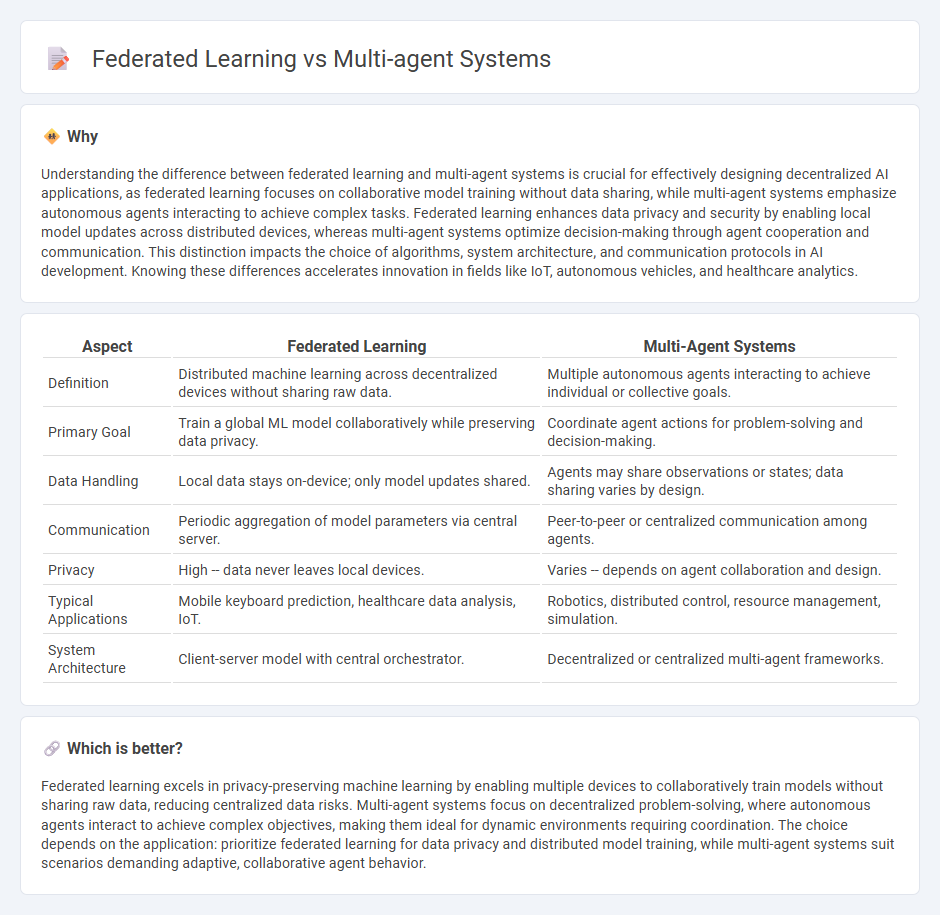
Federated learning enables decentralized model training across multiple devices while preserving data privacy, contrasting with multi-agent systems where autonomous agents interact to solve complex tasks collaboratively. Both approaches harness distributed computing but differ in focus: federated learning optimizes machine learning models without data centralization, whereas multi-agent systems emphasize coordination and decision-making among independent agents. Explore deeper insights into how these technologies revolutionize distributed intelligence and data processing.
Why it is important
Understanding the difference between federated learning and multi-agent systems is crucial for effectively designing decentralized AI applications, as federated learning focuses on collaborative model training without data sharing, while multi-agent systems emphasize autonomous agents interacting to achieve complex tasks. Federated learning enhances data privacy and security by enabling local model updates across distributed devices, whereas multi-agent systems optimize decision-making through agent cooperation and communication. This distinction impacts the choice of algorithms, system architecture, and communication protocols in AI development. Knowing these differences accelerates innovation in fields like IoT, autonomous vehicles, and healthcare analytics.
Comparison Table
| Aspect | Federated Learning | Multi-Agent Systems |
|---|---|---|
| Definition | Distributed machine learning across decentralized devices without sharing raw data. | Multiple autonomous agents interacting to achieve individual or collective goals. |
| Primary Goal | Train a global ML model collaboratively while preserving data privacy. | Coordinate agent actions for problem-solving and decision-making. |
| Data Handling | Local data stays on-device; only model updates shared. | Agents may share observations or states; data sharing varies by design. |
| Communication | Periodic aggregation of model parameters via central server. | Peer-to-peer or centralized communication among agents. |
| Privacy | High -- data never leaves local devices. | Varies -- depends on agent collaboration and design. |
| Typical Applications | Mobile keyboard prediction, healthcare data analysis, IoT. | Robotics, distributed control, resource management, simulation. |
| System Architecture | Client-server model with central orchestrator. | Decentralized or centralized multi-agent frameworks. |
Which is better?
Federated learning excels in privacy-preserving machine learning by enabling multiple devices to collaboratively train models without sharing raw data, reducing centralized data risks. Multi-agent systems focus on decentralized problem-solving, where autonomous agents interact to achieve complex objectives, making them ideal for dynamic environments requiring coordination. The choice depends on the application: prioritize federated learning for data privacy and distributed model training, while multi-agent systems suit scenarios demanding adaptive, collaborative agent behavior.
Connection
Federated learning and multi-agent systems are interconnected through their emphasis on decentralized data processing and collaborative model training across distributed agents. In federated learning, multiple devices or servers (agents) train local models using local data while sharing only model updates, preserving data privacy. Multi-agent systems facilitate coordination and communication among these distributed agents, enhancing efficiency and robustness in collective learning tasks.
Key Terms
**Multi-Agent Systems:**
Multi-agent systems (MAS) consist of multiple autonomous agents interacting within an environment to achieve individual or collective goals, often emphasizing decentralized control and communication. They are widely used in robotics, distributed AI, and complex decision-making processes, enabling dynamic problem-solving through cooperation or competition among agents. Explore more to understand how MAS frameworks compare to federated learning in scalability and privacy considerations.
Agent Communication
Multi-agent systems rely on direct agent communication protocols to enable decentralized cooperation and negotiation, enhancing real-time decision-making in dynamic environments. Federated learning focuses on model training across distributed nodes without sharing raw data, with communication centered around parameter updates and aggregation to preserve privacy and improve scalability. Explore deeper insights into how communication paradigms shape the efficiency and security of collaborative AI frameworks.
Distributed Coordination
Multi-agent systems enable distributed coordination by allowing autonomous agents to collaborate and make decisions based on local information, enhancing scalability and robustness in dynamic environments. Federated learning focuses on decentralized model training, where multiple devices collaboratively learn a global model without sharing raw data, preserving privacy and reducing communication overhead. Explore how these approaches revolutionize distributed coordination for advanced AI applications.
Source and External Links
What is a Multi Agent System - Relevance AI - Multi-agent systems (MAS) are distributed networks of intelligent, autonomous agents that sense, learn, and act individually and collectively, enabling flexibility, scalability, and robust problem-solving in real-world applications.
Multi-Agent Systems - Hugging Face Agents Course - Specialized agents in MAS collaborate on complex tasks, each with distinct roles (e.g., code interpreter, web searcher), orchestrated by a manager agent to improve modularity, scalability, and reliability.
What are Multi-Agent Systems? | NVIDIA Glossary - MAS are teams of specialized AI agents, each with unique capabilities and autonomy, working together to achieve a common goal and solve intricate problems with minimal human intervention.
 dowidth.com
dowidth.com